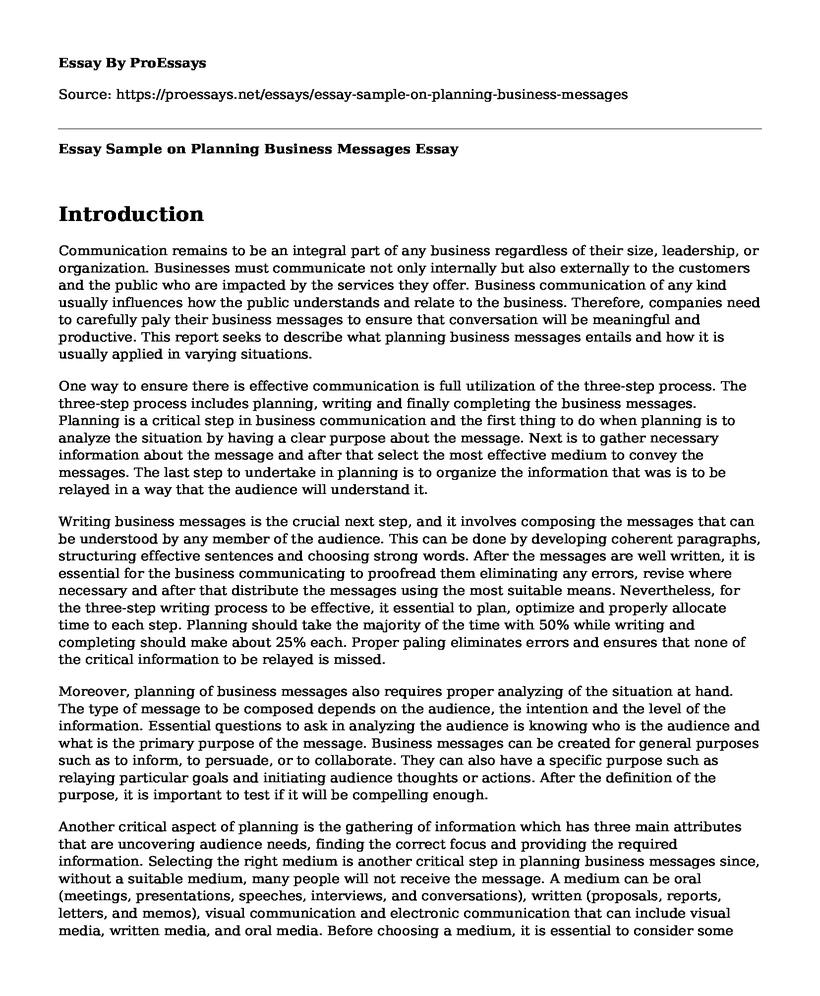Introduction
Communication remains to be an integral part of any business regardless of their size, leadership, or organization. Businesses must communicate not only internally but also externally to the customers and the public who are impacted by the services they offer. Business communication of any kind usually influences how the public understands and relate to the business. Therefore, companies need to carefully paly their business messages to ensure that conversation will be meaningful and productive. This report seeks to describe what planning business messages entails and how it is usually applied in varying situations.
One way to ensure there is effective communication is full utilization of the three-step process. The three-step process includes planning, writing and finally completing the business messages. Planning is a critical step in business communication and the first thing to do when planning is to analyze the situation by having a clear purpose about the message. Next is to gather necessary information about the message and after that select the most effective medium to convey the messages. The last step to undertake in planning is to organize the information that was is to be relayed in a way that the audience will understand it.
Writing business messages is the crucial next step, and it involves composing the messages that can be understood by any member of the audience. This can be done by developing coherent paragraphs, structuring effective sentences and choosing strong words. After the messages are well written, it is essential for the business communicating to proofread them eliminating any errors, revise where necessary and after that distribute the messages using the most suitable means. Nevertheless, for the three-step writing process to be effective, it essential to plan, optimize and properly allocate time to each step. Planning should take the majority of the time with 50% while writing and completing should make about 25% each. Proper paling eliminates errors and ensures that none of the critical information to be relayed is missed.
Moreover, planning of business messages also requires proper analyzing of the situation at hand. The type of message to be composed depends on the audience, the intention and the level of the information. Essential questions to ask in analyzing the audience is knowing who is the audience and what is the primary purpose of the message. Business messages can be created for general purposes such as to inform, to persuade, or to collaborate. They can also have a specific purpose such as relaying particular goals and initiating audience thoughts or actions. After the definition of the purpose, it is important to test if it will be compelling enough.
Another critical aspect of planning is the gathering of information which has three main attributes that are uncovering audience needs, finding the correct focus and providing the required information. Selecting the right medium is another critical step in planning business messages since, without a suitable medium, many people will not receive the message. A medium can be oral (meetings, presentations, speeches, interviews, and conversations), written (proposals, reports, letters, and memos), visual communication and electronic communication that can include visual media, written media, and oral media. Before choosing a medium, it is essential to consider some factors such as audience preferences, cost actors, message urgency, media limitations, message formality, and media richness.
Conclusion
Organizing this already gathered information is another critical step in planning business messages. Organizing information helps, the audience understand and accept the message, and it also saves their time since the information is bright for them. Information should have a good idea behind them, and these ideas can be derived by constructing questions and answers, having a journalistic approach, mind mapping, and brainstorming. Nevertheless, the scope of the message to be communicated should have limitations to ensure it matches the main idea. Moreover, it essential to choose the most appropriate approach when sending the message and this can be done through a direct or indirect approach. After the message is prepared, it is vital to develop a compelling message structure to ensure the message flows well and the audience can understand it.
Cite this page
Essay Sample on Planning Business Messages. (2022, Nov 05). Retrieved from https://proessays.net/essays/essay-sample-on-planning-business-messages
If you are the original author of this essay and no longer wish to have it published on the ProEssays website, please click below to request its removal:
- Essay Sample on Relevant Aspects of U.S. Law for Business
- Ethical Dilemma in Facebook Inc.
- Essay on Community-Based Nursing: A Catalyst for Quality Care and Improved Outcomes
- Research Paper on Parent-Teacher Partnership: A Key to Child Success
- Essay Example on Love & Theft: A Positive Interaction Between Whites & Blacks
- Report Sample on Coca-Cola's Growth: Current Strategies and Actions
- Paper Sample on Infant-Mother Attachment: Exploring the Secure Base







